|
Berryhill - the lungs of
the Potteries
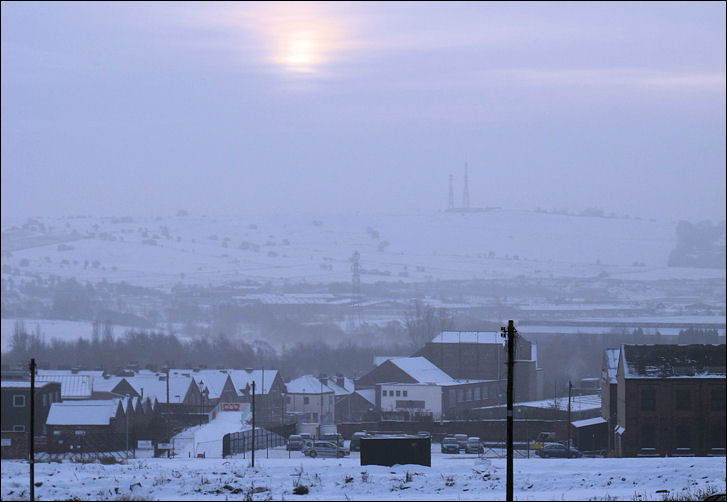
Berryhill Fields from
Lichfield Street
photo: Dec 2010
One of the more interesting views of Stoke-on-Trent is Berryhill Fields seen from the City Centre. As you walk along Charles Street past Hanley bus station the distant horizon rises up in an unnerving optical illusion. It’s like falling face forward to collide with a great gash of wild uncultivated field as it rears up to smack you in the face. This looming aspect is one we share with our distant ancestors. Framed around its undulating terrain the picture locks us into our heritage and provides a wistful backdrop to a city impotently surrendering its ties with the industry that put it on the map. It is a view familiar to Potteries’ archaeologist, Noel Boothroyd.
“Our story goes back 300 million years when the area was covered by tropical forest,” explains Noel. “Faults and folds over the ages have forced layers of coal, sandstone, clay and ironstone to the surface with the consequence that Berryhill has a long history of mining dating back to medieval times. But an important manorial site is known to have existed in the middle ages when a deer park once covered that dirty hill.”
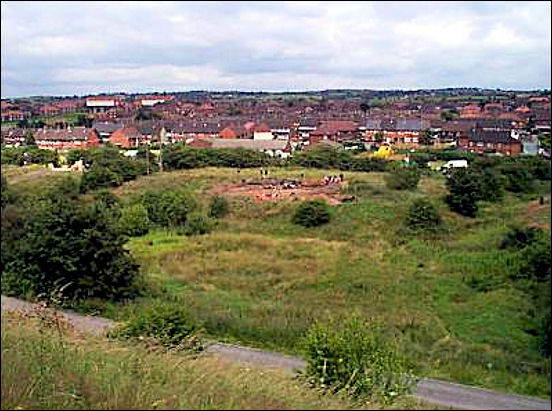
location of the
excavation work on Berryhill Fields
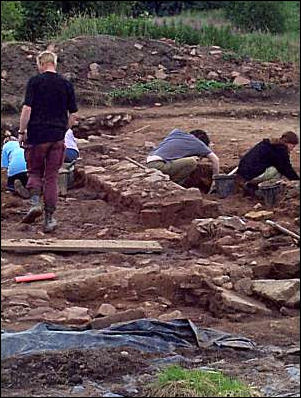
excavations of the manor
house in July 2000
The discovery of a dovecote in 1998 attracted much archaeological interest and with the help of Millennium Project funding the City Council and Groundwork Stoke-on-Trent organised a series of excavations in Berryhill in 2000 during which a moat-protected manor house was discovered. The digs involved contributions from Keele University History Department and were filmed for BBC 2 by television presenter Rory McGrath.
“The manor house was built in the 13th Century and was probably occupied for about two-hundred years,” says Noel. “It was clear that this was a very large building including detached store rooms and farm buildings. The main building comprised of a large hall measuring 13.5 by 11 metres providing evidence that a well-to-do family once lived
here."
Historians have suggested that the site could have been the manor of Fenton Vivian and Botteslow and, according to Noel, an important hunting lodge belonging to the principal Staffordshire family the Standons.
“It’s probable that Vivian Standon gave his name to that part of Fenton,” says Noel, “And in 1293 Robert Standon was the known landowner. The Black Death in the 14th century would have reduced the community when, in the early 1400s, it was owned by an absentee manorial lord in Hertfordshire. Some farming continued but we largely lose sight of developments until coal mining became the common industry around these parts.”
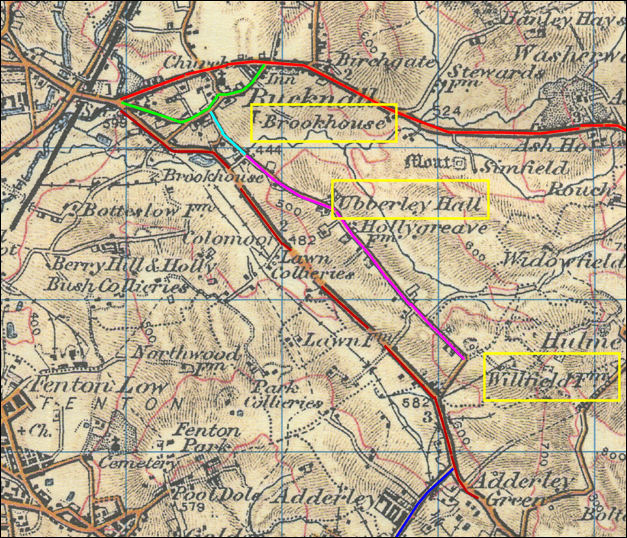
Map of the mines in the
Berryhill area c.1902
Berry
Hill, Holly Bush, Park, Lawn, Adderley Collieries can all be seen on this
map
Mining historian John Lumsdon fills in some gaps.
“There’s quite a lot of evidence of a coalmine at Berryhill dating back to the early nineteenth century,” says John. “But by 1961 all these pits were worked out and closed.”
In fact organised mining had been going on since 1628 when records identify locally-known names, Robert Bagnall, and the celebrated Longton mine owner Jeremiah Smith.
“The oldest known map of coal workings goes back to 1790,” says John, himself a former mine rescue manager who settled in the Potteries from his native North East. “By the early 1800s the whole landscape of Bucknall, Fenton, Ubberley and Berryhill was one huge series of coalmines. What a sight that must have been!”
In 1841 Berryhill colliery was owned by WT Copeland, the then owner of Spode China works. Then, by reason of a series of takeovers and amalgamations of other local pits, the major workings were closed down in the 1870s. Berryhill Colliery however continued under post-World War Two National Coal Board management with 503 underground workers until it finally closed in 1961 when, for a short time; after this it became a centre for mine rescue training.
Mining fatalities are common narratives fully told on the North Staffordshire Coalfield website created by John Lumsdon and his research team.
“You wouldn’t think to see the natural fields today there’d ever been workings here,” says John, “And yet under the ground there remains a sad legacy so typical of coal mining. There was a big explosion here in 1872 when 6 men were killed resulting from burns. The inquest heard that the men were using a candle close to a coal-drift which was filled with gas after shot had been fired. Lives of miners were cheap and even the inquest contrived to apportion blame not to management but to the dead. The coroner remarked that it was an act of stupidity to use naked lights and as far as he was concerned it showed the height of foolhardiness by ignorant miners. Although the jury recorded a verdict of accidental death it also criticised some miners for their own carelessness.”
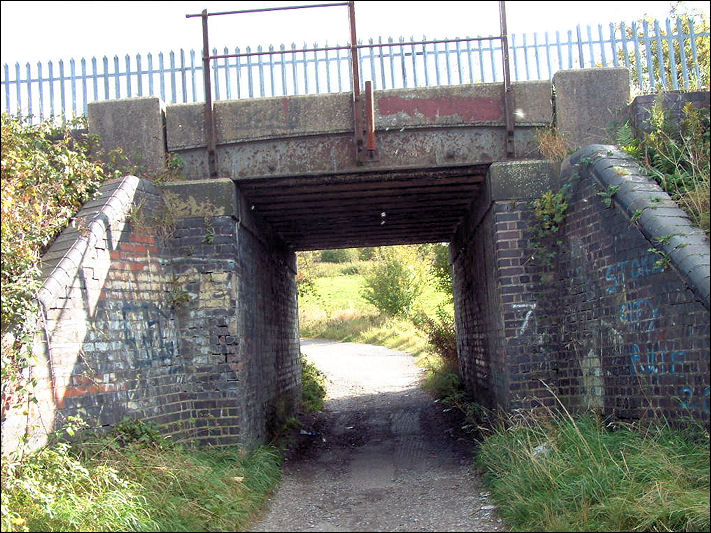
the low bridge which connects Joiners Square with Eaton Park housing
estate
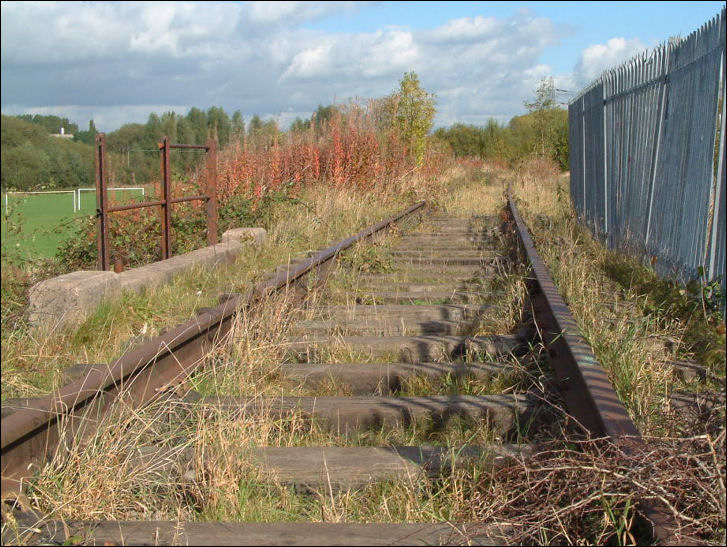
the disused rail line that runs from Cauldon to
Stoke
on the left is the Eastwood Football Club playing fields
photo: October 2009
At the bottom of Berryhill Fields is a disused rail line that runs from Cauldon to Stoke. A low bridge connects Joiners Square with Eaton Park housing estate. Here Mother Nature has reclaimed her land and today there are 70 acres of natural wilderness fully restored with wildlife overflowing with fish, fowl and flora. Yes it is bleak and lonesome but it is Stoke-on-Trent’s biggest area of natural countryside within the inner-city boundaries.
“Berryhill Fields are the lungs of the Potteries,” declares resident Terry Crowe. “With mining and pottery production everywhere, natural locations like Berryhill once provided the fresh air and respite from the smoke and dust of industry. That’s why we fought to preserve it!”
Former city and county councillor Terry is referring to the huge community campaign against proposals to opencast the entire fields following the pit closures of the late 1980s.
“It goes back fifteen years but it seems like only yesterday when we were openly fighting British Coal’s proposals,” Terry recalls.
I met Terry and two of his fellow campaigners Barry Stockley and Bernard Astley, at Berryhill High School and Sports College on the sprawling Eaton Park housing estate.
“My wife and I came to live in Eaton Park in 1966,” says 76 year old Bernard. “In fact we bought the last house of the first phase in Kettering Drive. In those days you could see for miles across the wild and open fields. After the pit closed the land on the top side was earmarked for housing. I can’t tell you how important those field were to the new community of Berryhill.”
Both Barry Stockley and Terry Crowe were councillors at the time of the opencast proposals.
“We discovered early on what British Coal was planning to do,” says Barry. “Can you imagine the effects on the district if opencast mining had taken place virtually in the City centre? Anyway in 1986 we immediately got organised and formed an action committee; and so began one desperate fight to raise funds to engage the best counsel we could afford.”
“And that’s where we beat them,” puts in Terry. “British Coal boasted that they’d never lost an application to opencast so we took them on with professionals and intense campaigning.”
“It went to appeal,” adds Barry. “We submitted over 5000 letters of support for our case. 5000 letters each individually written and composed so they couldn’t say we had just collected signatures. I think this impressed the commissioner who heard the appeal at Stoke Town Hall in 1993. I can see the Sentinel’s headlines now – ‘Berryhill is Thrown Out!’”
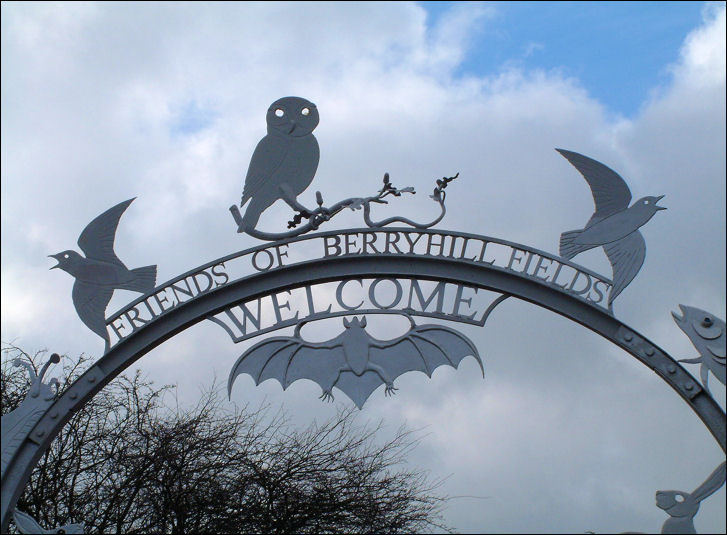
Friends of
Berryhill Fields - Welcome
photo: Jan 2006
The Sentinel was fully behind the battle reporting daily bulletins in its late edition. So intense was the campaign that a play called The Dirty Hill written by theatre director Peter Cheeseman was performed at the New Victoria Theatre to national interest and acclaim.
“And history records that we won,” concludes Bernard. “Since then Berryhill has grown in strength. What the community achieved has been endorsed by a massive investment of resources none of which would have been possible if the opencast had happened. The leisure facilities are superb and the Berryhill Village complex is internationally renowned.”
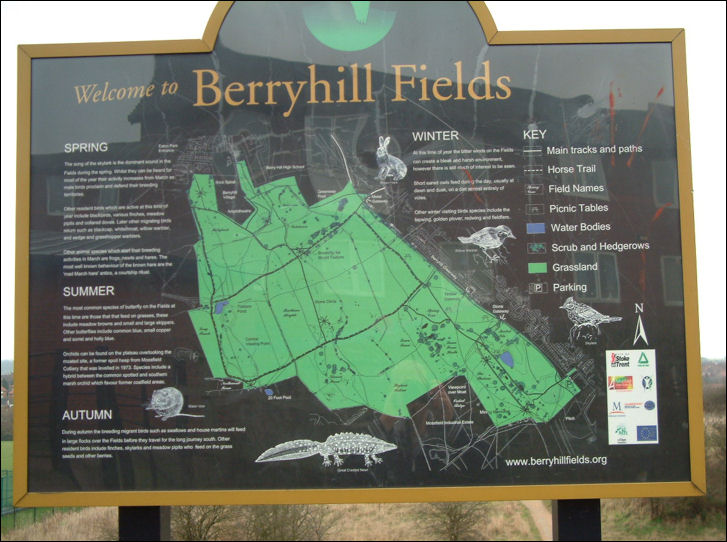
Just up the road from the high school is the Touchstone ExtraCare residential centre that provides accommodation for 180 elderly tenants. Popular resident 82 year old Elsie Jukes provides the link between then and now.
“I’ve lived in Berryhill for a great part of my life,” explains Elsie as she gives me a conducted tour of the pub, the restaurant, shop, library, gym and other amenities that make this complex appear like a luxury holiday site. “I came to live in the village two years ago from Eaton Park. This is my home now and I’m proud of it and love all my neighbours.”
Elsie’s son Keith Jukes was a prominent campaigner against opencast but sadly died before victory was acheived.
“Nevertheless,” says Barry Stockley, “It is to people like Keith that Berryhill owes a great debt of gratitude. Keith campaigned day and night and this complex is a tribute to his endeavours. In all my work as a councillor this is the achievement I am most proud to be associated with.”
Surrounded by flowers and shrubs in the centre of the village courtyard is a plaque to Keith’s memory.
“I’m really proud of what Keith did,” says Elsie. “He showed just what a community could achieve when it works together.”
It’s a message that’s reflected here in Berryhill Village whose inspiring motto says ‘we take for granted that this community will always have the right to choose.’
Fred Hughes

|
![]()
![]()
![]()